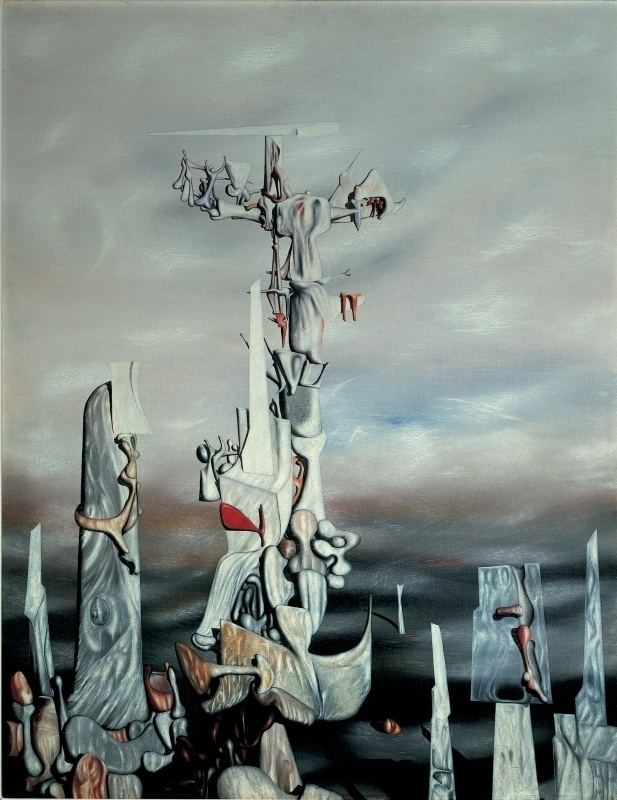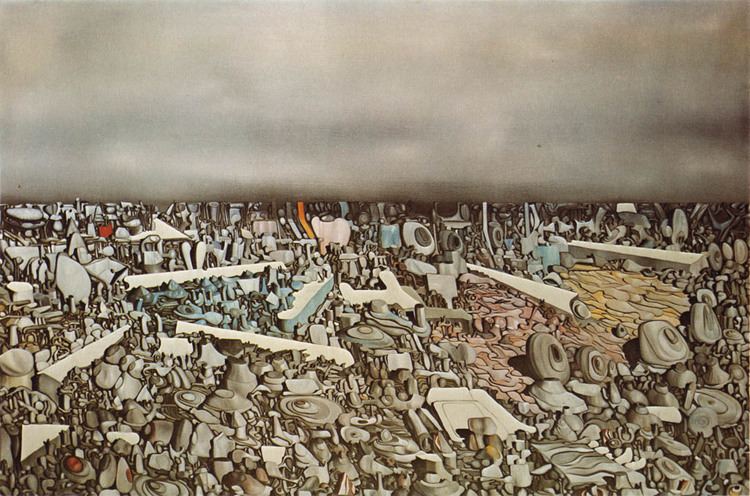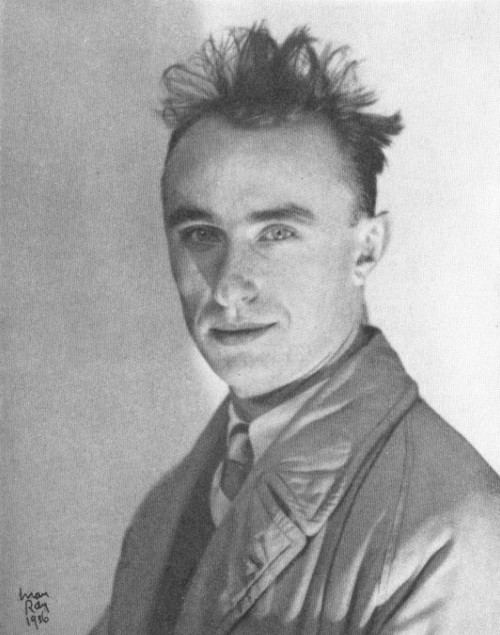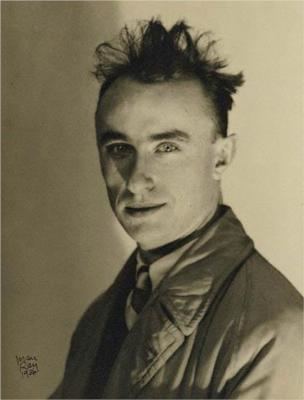 Siddhesh Joshi (Editor) Siddhesh Joshi (Editor)
I enjoy creating and spreading knowledgeable content for everyone around the world and try my best not to leave even the smallest of mistakes go unnoticed. Yves Tanguy Covid-19 French & American
Painting
Surrealism
| | Yves Tanguy
Surrealism
Pierre Matisse
| ) | Jan 5, 1900 (1900-01-05) Paris, French republic
Jan 15, 1955, Woodbury, Connecticut, United States
Mama - Papa Is Wounded!, The Furniture of Fourth dimension, The Rapidity of Sleep, Slowly Toward the Due north, Extinction of Useless Lights
Max Ernst, Kay Sage, Giorgio de Chirico, Andre Masson, Human being Ray | Raymond Georges Yves Tanguy (Jan 5, 1900 – Jan 15, 1955), known as Yves Tanguy, was a French surrealist painter. - Yves Tanguy Artworks
- Yves Tanguy
- Biography
- Style and legacy
- 1920s
- 1930s
- 1940s
- 1950s
- Books about Yves Tanguy
- References
  Tanguy, the son of a retired navy captain, was born at the Ministry of Naval Affairs on Place de la Concorde in Paris, France. His parents were both of Breton origin. After his begetter's death in 1908, his mother moved dorsum to her native Locronan, Finistère, and he ended upward spending much of his youth living with various relatives.  In 1918, Tanguy briefly joined the merchant navy earlier being drafted into the Army, where he befriended Jacques Prévert. At the finish of his military service in 1922, he returned to Paris, where he worked various odd jobs. He stumbled upon a painting by Giorgio de Chirico and was and then deeply impressed he resolved to become a painter himself in spite of his complete lack of formal training.  Tanguy had a habit of being completely captivated by the current painting he was working on. This mode of creating artwork may take been due to his very modest studio which only had plenty room for one wet piece.  Through his friend Prévert, in around 1924 Tanguy was introduced into the circle of surrealist artists around André Breton. Tanguy rapidly began to develop his ain unique painting style, giving his showtime solo exhibition in Paris in 1927, and marrying his kickoff wife Jeannette Ducrocq (1896-1977) afterward that same year. During this busy time of his life, Breton gave Tanguy a contract to paint 12 pieces a year. With his fixed income, he painted less and concluded up creating merely viii works of fine art for Breton. ) In Dec 1930, at an early screening of Buñuel and Dali's Fifty'Age d'Or, right-wing activists went to the lobby of the movie house where the film was being screened, and destroyed art works by Dalí, Joan Miró, Homo Ray, Tanguy, and others. Throughout the 1930s, Tanguy adopted the bohemian lifestyle of the struggling artist with gusto, leading eventually to the failure of his kickoff wedlock. He had an intense affair with Peggy Guggenheim in 1938 when he went to London with his wife Jeannette Ducrocq to hang his first retrospective exhibition in Britain at her gallery Guggenheim Jeune. The exhibition was a keen success and Guggenheim wrote in her autobiography that "Tanguy found himself rich for the get-go time in his life". She purchased his pictures Toilette de Fifty'Air and The Sun in Its Precious stone Case (Le Soleil dans son écrin) for her collection. Tanguy also painted Peggy ii beautiful earrings. The affair continued in both London and Paris and only finished when Tanguy met a boyfriend Surrealist artist who would become his second wife. In 1938, later on seeing the work of fellow artist Kay Sage, Tanguy began a relationship which led to his 2nd wedlock. With the outbreak of World State of war II, Sage moved back to her native New York, and Tanguy, judged unfit for military service, followed her. He would spend the remainder of his life in the United States. Sage and Tanguy were married in Reno, Nevada on Baronial 17, 1940. Toward the terminate of the state of war, the couple moved to Woodbury, Connecticut, converting an old farmhouse into an artists' studio. They spent the rest of their lives there. In 1948, he became a naturalized denizen of the United States. In Jan 1955, Tanguy suffered a fatal stroke at Woodbury. His body was cremated and his ashes preserved until Sage's death in 1963. Later, his ashes were scattered by his friend Pierre Matisse on the embankment at Douarnenez in his beloved Brittany, together with those of his wife. Style and legacy Tanguy's paintings have a unique, immediately recognizable style of nonrepresentational surrealism. They testify vast, abstruse landscapes, mostly in a tightly express palette of colors, simply occasionally showing flashes of contrasting colour accents. Typically, these conflicting landscapes are populated with various abstract shapes, sometimes angular and sharp equally shards of drinking glass, sometimes with an intriguingly organic look to them, like giant amoebae suddenly turned to rock. Co-ordinate to Nathalia Brodskaïa, Mama, Papa is Wounded! (1927) is one of Tanguy's virtually impressive paintings. He took the title of this and other works from psychiatric textbooks: "I remember spending a whole afternoon with ... André Breton," he said, "leafing through books on psychiatry in the search for statements of patients which could be used as titles for paintings." Brodskaïa writes that the painting reflects his debt to Giorgio de Chirico – falling shadows and a classical torso – and conjures upward a sense of doom: the horizon, the emptiness of the plain, the lone plant, the smoke, the helplessness of the small-scale figures. Tanguy said that it was an image he saw entirely in his imagination earlier starting to paint information technology. Tanguy'due south style was an important influence on several younger painters, such as Roberto Matta, Wolfgang Paalen, and Esteban Francés, who adopted a Surrealist way in the 1930s. Later, Tanguy's paintings (and, less directly, those of de Chirico) influenced the way of the French animated motion picture Le Roi et l'oiseau, by Paul Grimault and Prévert. Vite! Vite! (1924) Rue de la Santé (1925) The Museum of Modern Fine art, New York Self Portrait (1925) Individual Collection Dancing (1925) Private Drove The Testament of Jacques Prévert (1925) Private Collection Fantômas (1925–26) Individual Drove The Storm (1926) The Lighthouse (1926) Individual Drove, France The Girl with Carmine Pilus (1926) Private Collection Championship Unknown (The Giantess, The Ladder) (1926) Individual Collection I Came As I Had Promised. Bye (1926) Dieter Scharf Collection Foundation The Tempest (Black Mural) (1926) Philadelphia Museum of Art Woman Dreaming (Sleeping) (1926) Private Collection Composition (1927) Individual Drove A Large Painting Which is a Mural (1927) Expiry Watching His Family (1927) Thyssen-Bornemisza Museum, Madrid Second Message II (Third Message) (1927) Private Collection Someone Is Ringing (1927) Private Collection, Switzerland There! (The Evening Before) (1927) Menil Collection, Houston He Did What He Wanted (1927) Richard S Zisler Drove, New York Shadow Country (1927) The Detroit Institute of Arts Mama, Papa is wounded! (1927) The Museum of Modern Art, New York Extinction of Useless Lights (1927) The Museum of Modern Art, New York The Hand in the Clouds (1927) Staatsgalerie Stuttgart End What I Have Begun (1927) Individual Drove Belomancy I (1927) Museo Nacional Centro de Arte Reina Sofia, Madrid Surrealist Landscape (1927) Staatlishe Kunsthalle Karlsruhe Championship Unknown (Surrealist Composition) (1927) Ulla and Heiner Pietzsch Collection, Berlin Title Unknown (He Comes) (1928) Private Collection Onetime Horizon (1928) National Gallery of Australia, Canberra Unspoken Depths (1928) Private Collection The Dark Garden (1928) Kunstsammlung Nordrhein-Westfalen, Düsseldorf Tomorrow They Shoot Me (1928) Sara Hildén Fine art Museum, Tampere, Republic of finland Tabernacle (1928) Landscape with Red Deject (1928) Private Collection Title Unknown (1928) Cleveland Museum of Fine art, Ohio Indifferent Drouning/Indifferent Walnut Tree (1929) Private Collection Perfect Residue (1929) Gunter Sachs Collection Outside (1929) Scottish National Gallery of Modernistic Art, Edinburgh Lit Bleu (1929) Private Drove Inspiration (1929) Musée des Beaux-Arts de Rennes L'Avion (1929) The Look of Bister (1929) The National Gallery of Art, Washington DC The Lovers (1929) Museum Folkwang, Essen Derive d'Azur (1929) Museum Ludwig, Köln Out of the Blue (1929) Individual Collection The Pulp Sky (1929) Mount Holyoke College Museum Views (1929) Individual Collection Satin Pillow (1929) Art Gallery of Ontario, Toronto Cloud (1930) Private Collection La Splendeur Semblable (1930) Neither Legends Nor Figures (1930) Menil Collection, Houston Clouds of Earth (The Man) (1930) Private Collection Like Resplendence (1930) Kunstmuseum, Basel Tower of the West (1931) Kunstmuseum Winterthur Promontory Palace (1931) Peggy Guggenheim Collection, Venice The Armoire of Proteus (1931) Private Collection Four-Part Screen (The Empyrean) (1932) Berardo Collection, Lisbon The Center of the Tower (1933) Private Drove The Finality of the Never-Seen (1933) The Art Institute of Chicago Betwixt the Grass and the Air current (1934) Private Collection The End of the Rope (1934) Individual Collection I Am Waiting for Y'all (1934) Los Angeles County Museum of Art The Passage of a Smile (1935) The Toledo Museum of Art Échelles (1935) Manchester Art Gallery The Meeting-Place of Parallels (1935) Kunstmuseum, Basel Title Unknown (Metaphysical Mural) (1935) Staatsgalerie Stuttgart Palming (1935) Individual Drove, Hamburg The New Nomads (1935) John and Mable Ringling Museum of Art, Sarasota The Geometer of Dreams (1935) Private Collection Untitled (1935) Drove of Carlo F. Bilotti Heredity of Acquired Characteristics (1936) Menil Collection, Houston L'Extinction des Especes (1936) From the Other Side of the Bridge (1936) Private Collection, New York The Nest of the Amphioxus (1936) Museum of Grenoble Treasures of the Sea (1936) Private Collection Fragile (1936) Manner of Heredity (1936) Private Collection The Air in Her Mirror (1937) Sprengel Museum, Hanover Les Filles des Conséquences (1937) The Doubter (The Interrogation) (1937) Hirshhorn Museum and Sculpture Garden, Washington DC The Sunday in its Jewel Case (1937) Peggy Guggenheim Collection, Venice Lingering 24-hour interval (1937) Musée National d'Art Moderne, Heart Pompidou, Paris Movements and Acts (1937) Smith College Museum of Art Title Unknown (Mural) (1938) Individual Collection Familiar Little Person (1938) Musée National d'Art Moderne, Middle Pompidou, Paris Ennui and Repose (1938) Private Collection Colorlessness and repose (1938) The Jeffrey H. Loria Drove Hidden Thoughts (My Hidden Thoughts) (1939) San Francisco Museum of Modern Art If information technology Were (1939) Private Collection La Rue aux Levres (1939) The Article of furniture of Time (1939) The Museum of Mod Fine art, New York The Not bad Nacre Butterfly (1939) Individual Collection 2d Thoughts (1939) San Francisco Museum of Modern Art Satin Tuning-Fork (1939) Drove of Mr and Mrs Jacques Gelman The Satin Tuning Fork (1940) Belomancy II (1940) Private Collection The Witness (1940) Collection of Mr and Mrs Frederick R. Weisman A Little Later (1940) Individual Collection The Earth and the Air (1941) Baltimore Museum of Art On Slanting Ground (1941) Peggy Guggenheim Collection, Venice The Five Strangers (1941) Wadsworth Atheneum, Hartford The Palace of Windowed Rocks (1942) Musée National d'Art Moderne, Heart Pompidou, Paris Naked Water (1942) Hirshhorn Museum and Sculpture Garden, Washington DC The Long Pelting (1942) Honolulu Museum of Art Indefinite Divisibility (1942) Albright-Knox Fine art Gallery, Buffalo The Absent Lady (1942) Kunstsammlung Nordrhein-Westfalen, Düsseldorf The Great Mutation (1942) The Museum of Modern Art, New York Slowly Toward the Due north (1942) The Museum of Mod Art, New York The Stone in the Tree (1942) The Arizona State Academy Fine art Museum, Tempe Minotaur (1943) Fundació Joan Miró, Barcelona Through Birds, Through Fire and Non Through Glass (1943) The Minneapolis Establish of Arts Reply to Red (1943) The Minneapolis Constitute of Arts Zones D'Instabilite (1943) Equicocal Colors (1943) Private Collection The Prodigal Never Returns I (1943) Drove of Mr and Mrs Leonard Yaseen The Prodigal Never Returns II (1943) Collection of Mr and Mrs Leonard Yaseen The Prodigal Never Returns III (1943) Collection of Mr and Mrs Leonard Yaseen The Prodigal Never Returns 4 (1943) Drove of Mr and Mrs Leonard Yaseen Distances (1944) Private Collection Twice (1944) Private Collection The Tower of the Ocean (1944) Washington University Gallery of Art, St Louis My Life, White and Black (1944) Collection of Mr and Mrs Jacques Gelman The Rapidity of Sleep (1945) The Art Constitute of Chicago, Chicago There, Motion Has Not Notwithstanding Ceased (1945) Richard S Zeisler Collection, New York In that location the Mouth has not Ceased Yet (1945) Collection of Richard Due south. Zeisler The Provider (1945) Private Collectio Hands and Gloves (1946) Musée d'Art Moderne de Saint-Etienne Clothed in Wakefulness (1947) Collection of Mr and Mrs Isidore M. Cohen There Is (1947) Private Collection At the Take chances of the Sun (1947) Nelson Gallery - Atkins Museum, Kansas Metropolis From One Dark to Another (1947) de Young Museum, San Francisco Kickoff Stone (1947) Individual Collection Who Will Respond (1948) Collection of Mr and Mrs Herbert Lust Fearfulness (1949) Whitney Museum of American Art, New York Rose of the 4 Winds (1950) Wadsworth Atheneum, Hartford The Immense Window (1950) Individual Collection From Stake Hands to Weary Skies (1950) Yale University Art Gallery To look at in Winter (1950) Smith College Museum of Art Unlimited Sequences (1951) Pennsylvania Academy of Fine Arts, Philadelphia The Invisibles / The Transparent Ones (1951) Tate Modernistic, London The Hunted Sky (1951) Menil Collection, Houston Time Without Change (1951) University of Arizona Museum of Art, Tucson The Stars in Open up-Work (1951) The Art Institute of Chicago Considering (1951) Williams College Museum of Art This Morning time (1951) Drove of Nesuhi Ertegun Through the Forest (1952) The Delusion of Time (1954) The Metropolitan Museum of Art, New York The Saltimbanques (1954) Richard L Feigen, New York Imaginary Numbers (1954) Thyssen-Bornemisza Museum, Madrid From Green to White (1954) Collection of Mr and Mrs Jacques Gelman Multiplication of the Arcs (1954) The Museum of Modern Fine art, New York Olivier Berggruen, Yves Tanguy, Peintre De 50'Illusion Métaphysique in Yves Tanguy, Malingue (2002), pp. 9 - 13 An Of import Private Drove of Works by Yves Tanguy (2001) Published past Christie'south New York Yves Tanguy: The Graphic Work (1976) Published by Wolfgang Wittrock - Authors: Wolfgang Wittrock and Stanley W Hayter Yves Tanguy (1974) Published by Acquavella Galleries, Inc. - Authors: Nicholas G Acquavella and John Ashbery Yves Tanguy (1974) Published by Éditions Filipacchi - Author: Daniel Marchesseau Yves Tanguy (First Edition 1955, Second Edition 1977) Published by Museum of Modern Art - Writer: James Thrall Soby Double Solitaire: The Surreal Worlds of Kay Sage and Yves Tanguy (2011) Published past the Katonah Museum of Art and the Mint Museum with the Pierre Matisse Foundation, New York - Authors: Stephen Robeson Miller, Jonathan Stuhlman Yves Tanguy Wikipedia (Text) CC Past-SA |  Siddhesh Joshi (Editor)
Siddhesh Joshi (Editor) )





)
0 Response to "Yves Tanguy The Furniture of Time 1939 Art Style Name"
Post a Comment